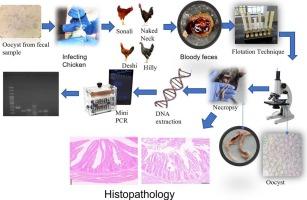Comparative susceptibility of native chicken breeds of Bangladesh to experimental Eimeria tenella infection
IF 1.4
Q3 PARASITOLOGY
Veterinary parasitology, regional studies and reports
Pub Date : 2025-10-01
DOI:10.1016/j.vprsr.2025.101353
引用次数: 0
Abstract
Eimeria tenella is the major protozoan parasite that causes coccidiosis in chickens, and its clinical and pathological response shows significant variations among breeds. This disease has a major economic impact on growers and the poultry industry worldwide. Very little information exists concerning the challenge infections of native chicken breeds of Bangladesh. The present study was undertaken to investigate and compare the pathology and clinical manifestations of experimental E. tenella infection among native (indigenous) chicken breeds of Bangladesh (Hilly, Naked Neck, and Deshi), in comparison to the susceptible exotic Sonali breed. In order to achieve this, a controlled experimental infection was carried out, and weight changes, Feed Conversion ratio (FCR), OPG counts, lesion severity, qPCR quantification of oocysts output, and dropping score were measured at 6, 10, and 14-Days post-infection (DPI). Distinct breed-specific differences in susceptibility were elicited. Sonali chickens exhibited the highest oocyst counts, reaching up to 103,200 at 14 DPI, along with significant weight loss and severe cecal pathology marked by diffuse hemorrhagic lesions. On the other hand, the indigenous breeds had low OPG counts as low as 100 in Hilly chickens, insignificant changes in weights, and mild pathological features characterized by reduced inflammation and hemorrhagic enteritis. This study highlights significant breed-specific differences in susceptibility to E. tenella, offering valuable insights into potential resistance or tolerance mechanisms. These findings support the use of native breeds in selective breeding programs aimed at improving disease resistance and underscore the importance of targeted control strategies for effective coccidiosis prevention and management.

孟加拉国本地鸡品种对实验性艾美耳球虫感染的比较易感性
柔嫩艾美耳球虫是引起鸡球虫病的主要原生动物寄生虫,其临床和病理反应在不同品种之间存在显著差异。这种疾病对全世界的种植者和家禽业造成重大经济影响。关于孟加拉国本地鸡品种的挑战感染的资料很少。本研究旨在调查和比较孟加拉国本地(本地)鸡品种(丘陵、裸颈和德什)与易感的外来索纳利鸡品种的实验性tenella感染的病理和临床表现。为此,进行了对照实验感染,在感染后6、10和14天(DPI)测量体重变化、饲料转化率(FCR)、OPG计数、病变严重程度、卵囊输出量qPCR定量和下降评分。引起了不同品种的敏感性差异。索纳利鸡表现出最高的卵囊计数,在14 DPI时达到103,200个,伴随着显著的体重减轻和严重的盲肠病理,以弥漫性出血性病变为特征。另一方面,本地品种丘陵鸡的OPG计数低至100,体重变化不明显,炎症和出血性肠炎减轻的病理特征较轻。这项研究强调了对软毛杆菌易感性的显著品种特异性差异,为潜在的抗性或耐受性机制提供了有价值的见解。这些发现支持在选择性育种计划中使用本地品种,旨在提高疾病抵抗力,并强调了有效预防和管理球虫病的目标控制策略的重要性。
本文章由计算机程序翻译,如有差异,请以英文原文为准。
求助全文
约1分钟内获得全文
求助全文
来源期刊
CiteScore
2.90
自引率
7.10%
发文量
126
审稿时长
97 days
期刊介绍:
Veterinary Parasitology: Regional Studies and Reports focuses on aspects of veterinary parasitology that are of regional concern, which is especially important in this era of climate change and the rapid and often unconstrained travel of people and animals. Relative to regions, this journal will accept papers of the highest quality dealing with all aspects of disease prevention, pathology, treatment, epidemiology, and control of parasites within the field of veterinary medicine. Also, case reports will be considered as they add to information related to local disease and its control; such papers must be concise and represent appropriate medical intervention. Papers on veterinary parasitology from wildlife species are acceptable, but only if they relate to the practice of veterinary medicine. Studies on vector-borne bacterial and viral agents are suitable, but only if the paper deals with vector transmission of these organisms to domesticated animals. Studies dealing with parasite control by means of natural products, both in vivo and in vitro, are more suited for one of the many journals that now specialize in papers of this type. However, due to the regional nature of much of this research, submissions may be considered based upon a case being made by the author(s) to the Editor. Circumstances relating to animal experimentation must meet the International Guiding Principles for Biomedical Research Involving Animals as issued by the Council for International Organizations of Medical Sciences (obtainable from: Executive Secretary C.I.O.M.S., c/o W.H.O., Via Appia, CH-1211 Geneva 27, Switzerland).

 求助内容:
求助内容: 应助结果提醒方式:
应助结果提醒方式:


